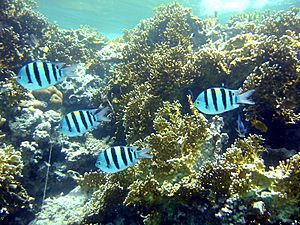Indo-Pacific sergeant facts for kids
Quick facts for kids Indo-Pacific sergeant |
|
|---|---|
 |
|
| Conservation status | |
| Scientific classification | |
| Synonyms | |
|
The Indo-Pacific sergeant (Abudefduf vaigiensis) is a cool fish found in warm ocean waters. It's sometimes called the Sergeant major. But usually, that name is for a very similar fish, Abudefduf saxatilis.
Contents
Where They Live

The Indo-Pacific sergeant lives in the Indo-Pacific region. This includes the Red Sea and parts of the Indian Ocean. You can find them near Arabia, the Persian Gulf, and Africa. They also live around Madagascar, Seychelles, Sri Lanka, and Australia.
In the Pacific Ocean, these fish are found in the Gulf of Thailand and Indonesia. They also swim near the Philippines, Taiwan, and Japan. You can spot them on the Great Barrier Reef and around Hawaii. For a while, people thought they were in the Mediterranean Sea. However, most of those fish turned out to be Abudefduf saxatilis, a different species.
What They Look Like
Indo-Pacific sergeants are bluish-white with a yellow top. They have a black spot near their dorsal fin. Their eyes are yellow.
This fish has 13 spines and 11 to 14 soft rays on its dorsal fin. Its anal fin has 2 spines and 11 to 13 soft rays. The biggest one ever recorded was about 20 centimeters (8 inches) long. Young fish become adults when they are about 12 centimeters (5 inches) long. When it's time to lay eggs, the males turn a brighter blue. Many people confuse this fish with Abudefduf saxatilis, which lives in the Atlantic Ocean.
How They Live
What They Eat
These fish eat tiny animals called zooplankton. They also munch on algae that grows on the bottom. Sometimes, they eat small invertebrates too.
Their Home
Adult Indo-Pacific sergeants live in coral reefs and tide pools. They also like rocky reefs. Baby fish, called larvae, live in the open ocean. These fish prefer warm, tropical, and subtropical waters. You can usually find them in water that is 1 to 15 meters (3 to 50 feet) deep.
Their Behavior
These fish often gather in large groups. In these groups, they either feed in the middle of the water or take care of their nests.
In Aquariums
You can sometimes find the Indo-Pacific sergeant in fish tanks. People keep them as pets in aquariums.
Life Cycle
Early Life
When the eggs hatch, the tiny larvae float out into the open ocean. They drift with the waves and grow bigger. Once they are old enough, they swim to a reef to live.
Reproduction
During breeding season, male Indo-Pacific sergeants become more bluish. They build nests on rocks or coral ledges. Females then lay their eggs in these nests. The male fertilizes the eggs. After that, the male guards the eggs and keeps them healthy until they hatch.
See also
 In Spanish: Abudefduf vaigiensis para niños
In Spanish: Abudefduf vaigiensis para niños


